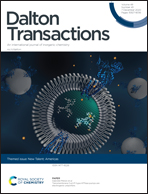Anticancer and antitrypanosomal activities of trinuclear ruthenium compounds with orthometalated phenazine ligands†
Abstract
Trinuclear ruthenium complexes with orthometalated phenazines of general formula [Ru3(μ3-O)(μ2-OAc)5(L)(py)2]PF6 (L = dppn, benzo[i]dipyrido[3,2-a:2′,3′-c]phenazine, 1; dppz, dipyrido[3,2-a:2′,3′-c]phenazine, 2; CH3-dppz, 7-methyldipyrido[3,2-a:2′,3′-c]phenazine, 3; Cl-dppz, 7-chlorodipyrido[3,2-a:2′,3′-c]phenazine, 4) were investigated for their cytotoxic activity toward the B16F10 murine melanoma and the L929 non-cancer cell lines and against Trypanosoma cruzi (2–4). This study also reports a multi-technique investigation into how complexes 1–4 interact with DNA and human serum albumin, HSA. At concentrations ranging from 2 to 50 μM, all the complexes reduced B16F10 murine melanoma cell viability by over 50%. Complex 4 had the highest cytotoxic effect in the series, diminishing B16F10 cell viability to 38% at 2 μM, with an overall order for anticancer activity of 4 > 2 > 3 > 1. Complexes 2–4 showed remarkable activity in inhibiting epimastigote and amastigote forms of T. cruzi. Complex 2 showed better antitrypanosomal activity than the reference drug (IC50 = 1.19 μM and IC50 = 0.25 μM for epimastigote and amastigotes forms, respectivily). Ethidium bromide (EB) displacement assays showed that DNA intercalation progressively increases with the extension of the π-conjugation of the cyclometalating ligand and the presence of substituents in the phenazinic portion (1 > 4–3 > 2), showing that complex 1 is a stronger intercalator than EB itself (Kapp > 107 M−1). Viscosity measurements followed the same trend. Cytotoxicity against cancer cells and antitrypanosomal activity follow the same order, which is different to the tendency of DNA intercalation, suggesting DNA is not the main target of these complexes. Compound 1–4 showed very high affinity with HSA (Kb ∼109 M−1). Circular dichroism results also showed that the complexes alter significantly the secondary structure of the HSA, lowering the α-helix % from 86.2 (pure protein) to less than 5% for compounds 1, 2 and 4 at 2.8 μM. These findings demonstrated the important role of phenazines for the biological activity of triruthenium compounds.

- This article is part of the themed collection: New Talent: Americas


 Please wait while we load your content...
Please wait while we load your content...